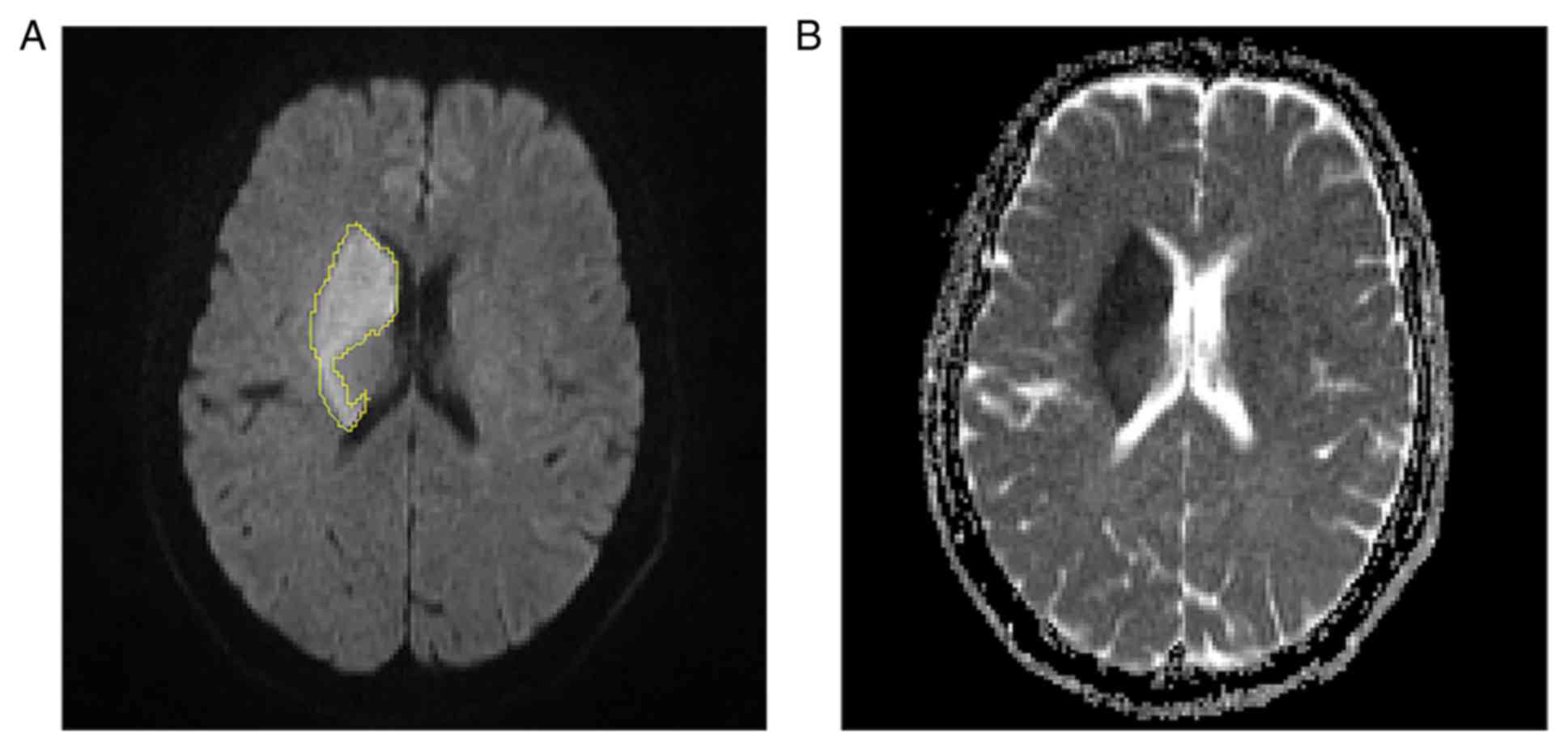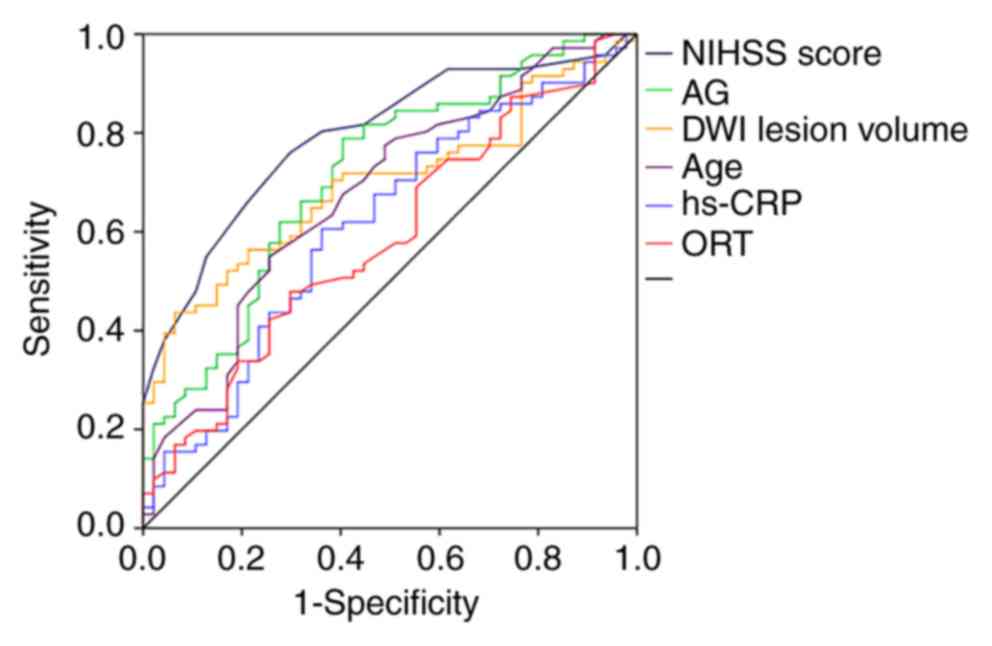|
1
|
Wufuer A, Wubuli A, Mijiti P, Zhou J,
Tuerxun S, Cai J, Ma J and Zhang X: Impact of collateral
circulation status on favorable outcomes in thrombolysis treatment:
A systematic review and meta-analysis. Exp Ther Med. 15:707–718.
2018.PubMed/NCBI
|
|
2
|
Hacke W: Interventional thrombectomy for
major stroke-a step in the right direction. N Engl J Med.
372:76–77. 2015. View Article : Google Scholar : PubMed/NCBI
|
|
3
|
Nogueira RG, Jadhav AP, Haussen DC, Bonafe
A, Budzik RF, Bhuva P, Yavagal DR, Ribo M, Cognard C, Hanel RA, et
al: Thrombectomy 6 to 24 h after stroke with a mismatch between
deficit and infarct. N Engl J Med. 378:11–21. 2018. View Article : Google Scholar : PubMed/NCBI
|
|
4
|
Bishop BM: Endovascular interventions for
acute ischemic stroke: A review of recent trials. Ann Pharmacother.
50:219–228. 2016. View Article : Google Scholar : PubMed/NCBI
|
|
5
|
Pfaff J, Rohde S, Engelhorn T, Doerfler A,
Bendszus M and Möhlenbruch MA: Mechanical thrombectomy using the
new solitaire™ platinum stent-retriever: Reperfusion results,
complication rates and early neurological outcome. Clin
Neuroradiol. 29:311–319. 2019. View Article : Google Scholar : PubMed/NCBI
|
|
6
|
Wang L, Zhou Z, Tian X, Wang H, Yang D,
Hao Y, Shi Z, Lin M, Wang Z, Zheng D, et al: Impact of relative
blood glucose changes on mortality risk of patient with acute
ischemic stroke and treated with mechanical thrombectomy. J Stroke
Cerebrovasc Dis. 28:213–219. 2019. View Article : Google Scholar : PubMed/NCBI
|
|
7
|
Cai Z, He W, Zhuang FJ and Chen Y: The
role of high high-sensitivity C-reactive protein levels at
admission on poor prognosis after acute ischemic stroke. Int J
Neurosci. 129:423–429. 2019. View Article : Google Scholar : PubMed/NCBI
|
|
8
|
Bunevicius A, Kazlauskas H, Raskauskiene
N, Mickuviene N, Ndreu R, Corsano E and Bunevicius R: Role of
N-terminal pro-B-type natriuretic peptide, high-sensitivity
C-reactive protein, and inteleukin-6 in predicting a poor outcome
after a stroke. Neuroimmunomodulation. 22:365–372. 2015. View Article : Google Scholar : PubMed/NCBI
|
|
9
|
Han M, Choi JW, Rim NJ, Kim SY, Suh HI,
Lee KS, Hong JM and Lee JS: Cerebral infarct volume measurements to
improve patient selection for endovascular treatment. Medicine
(Baltimore). 95:e47022016. View Article : Google Scholar : PubMed/NCBI
|
|
10
|
Padroni M, Bernardoni A, Tamborino C,
Roversi G, Borrelli M, Saletti A, De Vito A, Azzini C, Borgatti L,
Marcello O, et al: Cerebral blood volume aspects is the best
predictor of clinical outcome in acute ischemic stroke: A
retrospective, combined semi-quantitative and quantitative
assessment. PLoS One. 11:e01479102016. View Article : Google Scholar : PubMed/NCBI
|
|
11
|
Hirano T: Searching for salvageable brain:
The detection of ischemic penumbra using various imaging
modalities? J Stroke Cerebrovasc Dis. 23:795–798. 2014. View Article : Google Scholar : PubMed/NCBI
|
|
12
|
Jeong HG, Kim BJ, Choi JC, Hong KS, Yang
MH, Jung C, Han MK and Bae HJ: Posttreatment national institutes of
health stroke scale is superior to the initial score or
thrombolysis in cerebral ischemia for 3-month outcome. Stroke.
49:938–944. 2018. View Article : Google Scholar : PubMed/NCBI
|
|
13
|
Kim DH, Kim B, Jung C, Nam HS, Lee JS, Kim
JW, Lee WJ, Seo WK, Heo JH, Baik SK, et al: Consensus statements by
Korean society of interventional neuroradiology and Korean stroke
society: Hyperacute endovascular treatment workflow to reduce
door-to-reperfusion time. Korean J Radiol. 19:838–848. 2018.
View Article : Google Scholar : PubMed/NCBI
|
|
14
|
Beumer D, Rozeman AD, Lycklama À, Nijeholt
GJ, Brouwer PA, Jenniskens SF, Algra A, Boiten J, Schonewille W,
van Oostenbrugge RJ, Dippel DW, et al: The effect of age on outcome
after intra-arterial treatment in acute ischemic stroke: A MR CLEAN
pretrial study. BMC Neurol. 16:682016. View Article : Google Scholar : PubMed/NCBI
|
|
15
|
Powers WJ, Rabinstein AA, Ackerson T,
Adeoye OM, Bambakidis NC, Becker K, Biller J, Brown M, Demaerschalk
BM, Hoh B, et al: 2018 Guidelines for the Early management of
patients with acute ischemic stroke: A guideline for healthcare
professionals from the American Heart Association/American Stroke
Association. Stroke. 49:e46–e110. 2018. View Article : Google Scholar : PubMed/NCBI
|
|
16
|
Peng JW, Liu Y, Meng G, Zhang JY and Yu
LF: Effects of salvianolic acid on cerebral perfusion in patients
after acute stroke: A single-center randomized controlled trial.
Exp Ther Med. 16:2600–2614. 2018.PubMed/NCBI
|
|
17
|
Luo G, Mo D, Tong X, Liebeskind DS, Song
L, Ma N, Gao F, Sun X, Zhang X, Wang B, et al: Factors associated
with 90-day outcomes of patients with acute posterior circulation
stroke treated by mechanical thrombectomy. World Neurosurg.
109:e318–e328. 2018. View Article : Google Scholar : PubMed/NCBI
|
|
18
|
Stoltzfus JC: Logistic regression: A brief
primer. Acad Emerg Med. 18:1099–1104. 2011. View Article : Google Scholar : PubMed/NCBI
|
|
19
|
Meurer WJ and Tolles J: Logistic
regression diagnostics: Understanding how well a model predicts
outcomes. JAMA. 317:1068–1069. 2017. View Article : Google Scholar : PubMed/NCBI
|
|
20
|
Amitrano D, Silva IR, Liberato BB,
Batistella V, Oliveira J and Nascimento OJ: Simple prediction model
for unfavorable outcome in ischemic stroke after intravenous
thrombolytic therapy. Arq Neuropsiquiatr. 74:986–989. 2016.
View Article : Google Scholar : PubMed/NCBI
|
|
21
|
Wu Z, Zeng M, Li C, Qiu H, Feng H, Xu X,
Zhang H and Wu J: Time-dependence of NIHSS in predicting functional
outcome of patients with acute ischemic stroke treated with
intravenous thrombolysis. Postgrad Med J. 95:181–186. 2019.
View Article : Google Scholar : PubMed/NCBI
|
|
22
|
Soriano-Tárraga C, Mola-Caminal M,
Giralt-Steinhauer E, Ois A, Rodríguez-Campello A, Cuadrado-Godia E,
Gómez-González A, Vivanco-Hidalgo RM, Fernández-Cadenas I, Cullell
N, et al: Biological age is better than chronological as predictor
of 3-month outcome in ischemic stroke. Neurology. 89:830–836. 2017.
View Article : Google Scholar : PubMed/NCBI
|
|
23
|
Kim TH and Vemuganti R: Effect of sex and
age interactions on functional outcome after stroke. CNS Neurosci
Ther. 21:327–336. 2015. View Article : Google Scholar : PubMed/NCBI
|
|
24
|
Möbius C, Blinzler C, Schwab S, Köhrmann M
and Breuer L: Re-evaluation of the stroke prognostication using age
and NIH Stroke Scale index (SPAN-100 index) in IVT
patients-the-SPAN 10065 index. BMC Neurol. 18:1292018.
View Article : Google Scholar : PubMed/NCBI
|
|
25
|
Jadhav AP, Desai SM, Kenmuir CL, Rocha M,
Starr MT, Molyneaux BJ, Gross BA, Jankowitz BT and Jovin TG:
Eligibility for endovascular trial enrollment in the 6- to 24-h
time window: Analysis of a single comprehensive stroke center.
Stroke. 49:1015–1017. 2018. View Article : Google Scholar : PubMed/NCBI
|
|
26
|
Todo K, Sakai N, Kono T, Hoshi T, Imamura
H, Adachi H and Kohara N: National institutes of health stroke
scale-time score predicts outcome after endovascular therapy in
acute ischemic stroke: A retrospective single-center study. J
Stroke Cerebrovasc Dis. 25:1187–1191. 2016. View Article : Google Scholar : PubMed/NCBI
|
|
27
|
Koizumi S, Ota T, Shigeta K, Amano T, Ueda
M, Matsumaru Y, Shiokawa Y and Hirano T: Onset to reperfusion time
was not important in mechanical thrombectomy for elderly patients:
A retrospective multicenter study in Tama area, Tokyo. Cerebrovasc
Dis. 46:89–96. 2018. View Article : Google Scholar : PubMed/NCBI
|
|
28
|
White BM, Magwood GS, Burns SP and Ellis C
Jr: Sex differences in patient-reported poststroke disability. J
Womens Health (Larchmt). 27:518–524. 2018. View Article : Google Scholar : PubMed/NCBI
|
|
29
|
Oskui PM, French WJ, Herring MJ, Mayeda
GS, Burstein S and Kloner RA: Testosterone and the cardiovascular
system: A comprehensive review of the clinical literature. J Am
Heart Assoc. 2:e0002722013. View Article : Google Scholar : PubMed/NCBI
|
|
30
|
Tonetti DA, Gross BA, Desai SM, Jadhav AP,
Jankowitz BT and Jovin TG: Final infarct volume of <10
cm3 is a strong predictor of return to home in
nonagenarians undergoing mechanical thrombectomy. World Neurosurg.
119:e941–e946. 2018. View Article : Google Scholar : PubMed/NCBI
|
|
31
|
Kim SM, Kwon SU, Kim JS and Kang DW: Early
infarct growth predicts long-term clinical outcome in ischemic
stroke. J Neurol Sci. 347:205–209. 2014. View Article : Google Scholar : PubMed/NCBI
|
|
32
|
Liggins JT, Yoo AJ, Mishra NK, Wheeler HM,
Straka M, Leslie-Mazwi TM, Chaudhry ZA, Kemp S, Mlynash M, Bammer
R, et al: A score based on age and DWI volume predicts poor outcome
following endovascular treatment for acute ischemic stroke. Int J
Stroke. 10:705–709. 2015. View Article : Google Scholar : PubMed/NCBI
|
|
33
|
Wada S, Yoshimura S, Inoue M, Matsuki T,
Arihiro S, Koga M, Kitazono T, Makino H, Hosoda K, Ihara M and
Toyoda K: Outcome prediction in acute stroke patients by continuous
glucose monitoring. J Am Heart Assoc. 7(pii):
e0087442018.PubMed/NCBI
|
|
34
|
Zhu Z, Yang J, Zhong C, Xu T, Wang A, Bu
X, Peng Y, Peng H, Xu T, Chen CS, et al: Abnormal glucose
regulation, hypoglycemic treatment during hospitalization and
prognosis of acute ischemic stroke. J Neurol Sci. 379:177–182.
2017. View Article : Google Scholar : PubMed/NCBI
|
|
35
|
Zhang X, Huang WJ and Yu ZG: Relationship
between the hypersensitive c-reactive protein (hs-CRP) level and
the prognosis of acute brainstem infarction. Cell Biochem Biophys.
72:107–110. 2015. View Article : Google Scholar : PubMed/NCBI
|
|
36
|
Meng X, Wen R and Li X: Values of serum
LDL and PCT levels in evaluating the condition and prognosis of
acute cerebral infarction. Exp Ther Med. 16:3065–3069.
2018.PubMed/NCBI
|
|
37
|
Billington CK, Appleton JP, Berge E,
Sprigg N, Glover M and Bath PMW: Impact of hydration status on
haemodynamics, effects of acute blood pressure-lowering treatment
and prognosis after stroke. Br J Clin Pharmacol. 84:2914–2922.
2018. View Article : Google Scholar : PubMed/NCBI
|
















